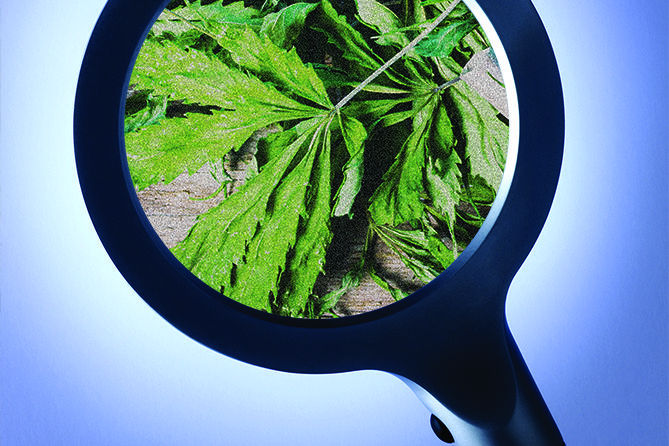Two veteran growers explain why you can cure newly harvested marijuana in a matter of days, not weeks or months
By Omar Sacirbey
In an ideal world, cultivators would have the luxury of time when it comes to drying and curing their cannabis. They’d take 30-60 days – waiting, sniffing, eyeing and “burping” – to achieve the ideal cannabinoid and terpene profile for each lovingly grown flower.
But in the real business world, larger cultivators need to get product out the door. They don’t have one or two months to spend on curing. Does that mean cultivators need to sacrifice quality for large-scale commercial production?
Not necessarily, according to Mojave Morelli, director of agriculture at Grow Op Farms, a producer-processor that grows about 2,000 pounds of marijuana per month in an indoor facility near Spokane, in Washington state.
“We’re moving product so fast that we really don’t have time to do a 30- or a 60-day cure,” Morelli said. And frankly, Morelli noted, cannabis isn’t necessarily that much better – if any better at all – after a 30- or 60-day cure.
“Ultimately, what everybody should be looking for is flower that’s good 10 days after harvest,” he said. “If it’s dry, put it in your pipe and smoke it. If it’s smooth and flavorful and it’s not harsh, that’s what we want to grow: something where you don’t have to send it through this whole process to get good flower. At the end of the day, when we produce as much as we can, that’s what we’re left to work with.”
Morelli and other growers believe that with a simple, properly executed strategy, well-grown flower needs only a couple of weeks (give or take) to reach top-shelf quality.
“What we’re trying to do is achieve the kind of terpene and cannabinoid profile that we want,” said Corey Barnette, CEO and chief grower at District Growers, a producer-processor in Washington DC. “We’re going in and we’re examining that, and we’re letting that happen naturally.”
Starting the Process
At Gro Op, that strategy usually begins about two days before harvest, when its crew lowers the temperature in the soon-to-be harvested room from about 70 degrees to about 65 degrees and lets the medium (coco in Grow Op’s case) dry out. That, Morelli said, helps reduce humidity in the room and starts the drying process.
Grow Op, which has a team of 25 devoted solely to harvesting, drying and curing, then lets the plants spend a day or two in the dark, which helps develop the resin glands and overall ripening of the flower.
The grow team then begins the harvest. While some growers prefer to harvest the whole plant and hang it to dry, Morelli instructs his staff to cut branches that are roughly the length of a fingertip to the beginning of the elbow. Most of the company’s rooms have 56 lights and 210 plants, which typically take two or three hours to harvest. But some rooms contain about 100 lights and can take as much as half a day to harvest, he said.
After getting cut, the branches are sent to drying rooms – which are typically 10 feet by 20 feet, although Grow Op has some that are 20 feet by 20 feet – and hung on hooks attached to lines that run the width of the room.
In the Drying Room
The drying rooms have air conditioning, dehumidification, air purification “and a lot of air movement, but gentle air movement,” Morelli said.
“Blasting” fans directly onto the hanging branches damages trichomes and the integrity of the flower, Morelli said. “The branches shouldn’t be rocking back and forth in the wind, but just slightly fluttering.”
Grow Op uses 10-inch fans made by Hyper Fan in each room that pull air from inside the grow facility, where temperatures are usually 65-70 degrees, through a carbonator into the drying room. Once the air is in the room, it travels like a “curtain of air,” Morelli said.
The air exits from the other side of the room via another 10-inch fan that performs the outtake. That exhaust fan is set on a timer, so that three to five times per day it can remove the old air and suck in new air.
“Depending on the day, we may run those more or less continuously to manage the humidity in the room. Obviously, you take 1,500 to 2,000 pounds of wet flower from a harvest and throw it into a room, you’re going to have pretty high humidity,” Morelli said.
Morelli said the drying process typically takes seven to 10 days, depending on the strain and the conditions in the building at a particular time. Barnette, by contrast, said District Growers dries branches within three to five days.
In the drying rooms, Grow Op tries to keep the temperature at about 70 degrees and the humidity at 60%. The grow staffers hold those conditions almost until the end of the drying process, then lower the humidity to about 55% when they want to start pulling down the dried branches.
Generally, once the flower’s moisture content gets down to 12.5%-13%, the grow staff start removing flower from stem. The untrimmed flower is then either sent to be trimmed or to extraction.
The ideal drying condition would be 70 degrees and 60% humidity at all times and take as long as needed to get the flower to a moisture content of 12.5%-13%, Barnette said.
Into the Bins
After hitting that preferred moisture content level, employees put the flower into 20-gallon “Rubbermaid-like” storage containers, which they outfit with custom-built nylon liners, the same kind of material used to make turkey bags.
The flower is then sent for testing at an outside lab. If all goes well, the flower is transferred to “quarantine” for anywhere between a day and two weeks. Those rooms are kept dark and at 62-65 degrees and 55% humidity.
During that time, grow employees will “burp” the bins. Burping involves lifting the lids of the containers for 10-20 seconds to allow gases that have built up to escape. At the same time, fresh air is introduced, and staffers inspect the flower’s moisture. The grow staff will generally burp the containers every other day or so, Morelli said.
“That’s the life they live until they hit the trim table,” Morelli said.
After trimming, the flower next goes into glass containers that Grow Op sends to its retail customers, and the flower undergoes additional curing in the jars.
While longer cures may not be the most conducive for larger cultivators, Morelli believes they could be a more viable option for smaller growers.
Morelli suggests smaller growers cure their cannabis in glass jars, although stainless steel isn’t a bad second option, he said.
Once the flower is in the container, Morelli suggests keeping it in a cool, dark room – because light degrades cannabis – at about 55% humidity, ideally for 20-30 days in the case of a boutique grower who has the time.
“If you’re growing right, your bud should be ready to smoke a couple weeks after you harvest it,” Morelli said. “But if you can wait, 30 days is perfect.”





